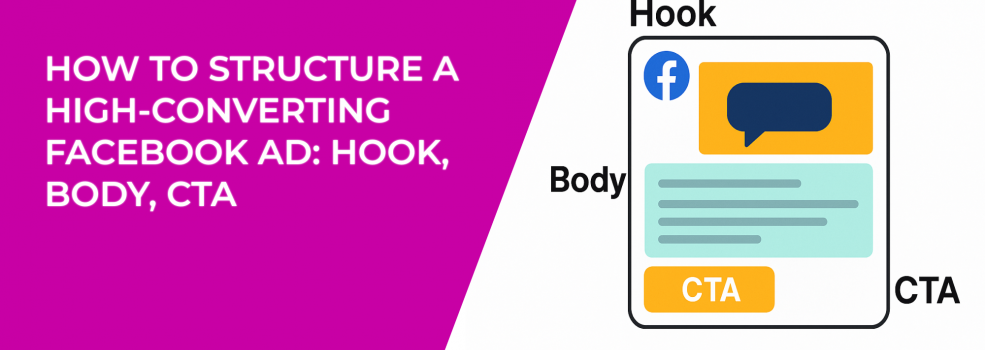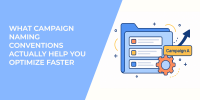A great Facebook ad doesn’t happen by accident. It’s built piece by piece, with every element working to stop the scroll, spark interest, and push the right people toward action.
Three parts matter most — the hook, the body, and the call to action (CTA).
Let’s break them down so you can build ads that do more than get clicks — they convert.
1. The Hook — Grabbing Attention in a Split Second
Your hook is the headline of your ad world. On Facebook, it could be the very first sentence in your copy, the bold text above your image, or the visual itself.
The feed is noisy. You’re competing with baby photos, travel reels, and other ads. You get one shot to make someone stop scrolling.
Tips and strategies for stronger hooks:
-
Lead with numbers — Stats, percentages, or dollar amounts catch the eye. Example: “Cut your shipping costs by 43% in 30 days.”
-
Ask a thought-provoking question — Something that makes the reader pause and think. Example: “How many hours did you waste on admin work this week?”
-
Paint a vivid picture — Use sensory or emotional language to make the benefit feel real.
-
Address a pain point directly — Show you understand the frustration your audience feels.
-
Use power words — Words like “discover,” “unlock,” “finally,” and “proven” can increase curiosity.
-
Test visuals aggressively — Try lifestyle images, bold product close-ups, clean flat lays, or unusual angles. The right creative can double your CTR without touching the copy.
Tip: Avoid generic hooks like “Check out our product” or “We’re the best solution.” They blend in with every other ad. Your hook should feel like it’s speaking directly to a problem or goal your audience cares about.
Ask yourself: Would this make me pause if I were my own target audience? If not, refine it.
If you want to dive deeper into how to make your opening lines and visuals irresistible, check out our guide on The Psychology of Facebook Ads: How to Hook Your Target Audience in Seconds.
2. The Body — Turning Interest into Desire
Once the hook pulls people in, the body copy has one job: build enough trust and interest so the click feels like the obvious next step.
This is where you explain why your offer matters, without drowning people in details.
Strategies for writing compelling body copy:
-
Start with empathy — Show you understand the reader’s current situation before introducing your offer.
-
Highlight a clear benefit first — Make sure it’s something that directly impacts your audience’s life or business.
-
Back it up with proof — Testimonials, reviews, case studies, or quick metrics can establish credibility fast.
-
Create a mini-story — Even a two-sentence narrative can help people imagine themselves benefiting from your solution.
-
Use formatting for easy reading — Break up big blocks of text into 1–2 sentence paragraphs. Use emojis sparingly to guide the eye (especially for consumer brands).
-
Address objections early — If cost, complexity, or trust are likely barriers, acknowledge them and offer a reassurance.
Example: For a fitness coaching program, a strong body copy might be: You’ve tried every plan under the sun, but the weight never stays off. Our program combines tailored workouts, 1:1 coaching, and real accountability. Over 4,000 clients have transformed their routines and kept the results for years.
Tip: Every line should answer the silent question in the reader’s head — “Why should I care?”
Well-crafted storytelling works even better when your visuals carry the same tone and message — our guide Stand Out and Stay On-Brand with Stunning Facebook Ad Creatives shows you how to make that happen.
3. The CTA — Closing the Gap Between Interest and Action
The call to action is where attention becomes action. On Facebook, that could mean clicking to your landing page, starting a free trial, signing up for a webinar, or making a purchase.
A weak CTA can sink an otherwise great ad.
Specifying the action you want users to take in the ad's description can provide more context and make your offer clearer.
Tips for high-performing CTAs:
-
Make it benefit-driven — Instead of “Learn More,” say “See How to Save 5 Hours a Week.”
-
Use urgency carefully — Phrases like “Join Today” or “Offer Ends Friday” can work, but don’t fake scarcity.
-
Match your offer stage — Cold audiences may respond better to softer asks like “Get Your Free Guide” than to “Buy Now.”
-
Keep it action-oriented — Start with verbs: “Start,” “Discover,” “Unlock,” “Claim,” “Watch.”
-
Reinforce the value one last time — Pair your CTA with a mini-benefit: “Start your free trial — cancel anytime.”
Example: For an online course, a weak CTA might be “Sign Up.” A stronger one: “Start learning today — your first lesson is free.”
Tip: Test both button text and surrounding copy. Sometimes the supporting sentence above your CTA drives the biggest lift in conversions.
Your CTA will perform even better if your campaign objectives are set up correctly. Learn how to choose the right one in Meta Ad Campaign Objectives Explained: How to Choose the Right One.
Putting It All Together
When your hook, body, and CTA work in sync, you create a smooth flow from curiosity to desire to action. Here’s how it might look:
- Hook: Lose 5 hours of wasted work every week — starting today.
- Body: Small inefficiencies drain your time. Our productivity app tracks, automates, and organizes in minutes. Thousands of teams save hours every week — you could be next.
- CTA: Start your free trial now.
It’s tight, consistent, and speaks directly to the user’s needs from start to finish.
Final Thoughts
If you want your Facebook ads to start converting at a higher rate, don’t just read this and move on. Apply it.
Here’s how to put this structure into action starting today:
-
Audit your current ads — Identify which part is weakest: the hook, the body, or the CTA. Fix the weakest link first.
-
Write three new hooks for your top-performing ad. Test them against each other to see which one stops the scroll best.
-
Refine your body copy so the main benefit appears in the first two sentences. Add one proof element for credibility.
-
Create two CTA variations — one soft and one direct — and track which drives more clicks or conversions.
-
Review your results weekly and keep iterating. Small, consistent improvements compound over time.
High-converting ads don’t happen from guesswork. They’re built through a mix of structure, testing, and audience insight.
If you follow these steps, you’ll quickly see which messages resonate — and which deserve to be cut.
The feed is moving fast. Your audience is scrolling now.
The best time to build your next winning ad is before someone else grabs their attention.

